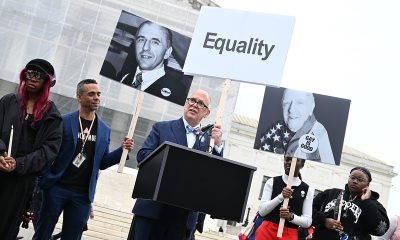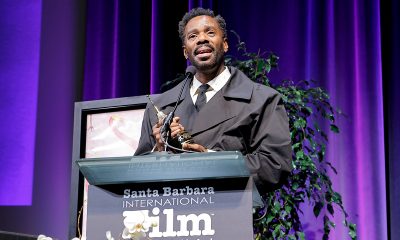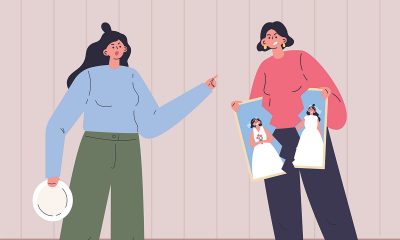Opinions
March on Washington inspired gay activists
Witnessing King’s speech a seminal moment in my life

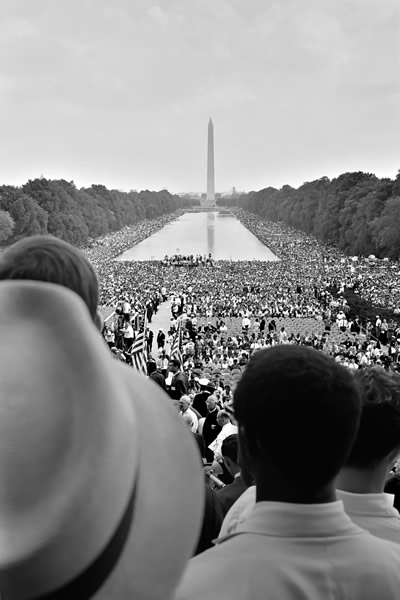
On Aug. 28, 1963, Malcolm Lazin joined an estimated 250,000 black and some white Americans at the Lincoln Memorial for the March on Washington for Jobs and Freedom. (Photo public domain)
By MALCOLM LAZIN
In 1961, my senior year in a rural Central Pennsylvania high school, I competed in the oratorical contest with a speech titled, “The Plight of the American Negro.” My teacher informed me if I wanted to win, I had chosen a wrong and contentious topic. While I was raised in the North, attitudes about Negroes were similar to those in the South.
From a relatively inactive movement in early 1960, dramatic events for racial equality captured national attention between 1961 and 1963: Freedom Rides, Interstate Commerce Commission’s desegregation order, Voting Education Project, integration of the University of Mississippi, Gov. George Wallace’s intervention against desegregating the University of Alabama, Dr. King’s Letter from Birmingham Jail, national awareness of White Citizens Council and Ku Klux Klan brutality.
When I arrived in the capital as a collegian to take summer classes in 1963, I heard about a national demonstration planned at the Lincoln Memorial for late August. Washington was not only below the Mason-Dixon line, but it was then in many ways a southern city. Few “blacks” attended Washington’s white colleges and universities. Black collegians attended Howard University. At my college, there were two black undergraduates, one of whom was from Africa. Job opportunities for non-college educated blacks were servile. College-educated blacks were principally offered positions as teachers in colored public schools and ministers in colored churches.
The Kennedy administration, expecting riots and looting incited by the rally at the Lincoln Memorial, discouraged the demonstration. Lead organizers A. Philip Randolph and openly gay Bayard Rustin were not deterred.
On Wednesday, Aug. 28, 1963, I joined an estimated 250,000 black and some white Americans at the Lincoln Memorial for the March on Washington for Jobs and Freedom. For me, it was important that I attend. Being a Jewish American, the Holocaust was a recent and painful reminder of unfettered prejudice. Negro lynchings without arrests reminded me of the horror of the pogroms that Jews experienced in Europe while authorities looked the other way.
The March was a magical moment. Ordinary folks, mostly dressed as if they were going to church arrived from rural towns and large cities. Despite the repression, they were not intimidated. The magnitude of the largest crowd ever assembled on the National Mall inspired everyone. The statue of the Great Emancipator symbolized the long sought aspirations for a better life, equality and equal justice.
It was a hot day with lots of speeches. While Dr. King is recognized today as America’s preeminent civil rights leader, his numerous co-organizers also spoke that day. I remember two. One was by Rabbi Joachim Prinz, president of the American Jewish Congress. Jews were among the early white supporters. Rabbi Prinz was a German Jew who emigrated to the U.S. to escape Nazi persecution. His speech lived up to his honored placement between Mahalia Jackson’s spirituals and Dr. King’s speech.
When Dr. King began “I Have a Dream,” I was struck as if by lightning. It was akin to hearing Moses speak to the heavens. Inherently, I knew that the speech was a defining moment for those assembled and for Americans watching televisions in living rooms across the nation. The march led to the Civil Rights Act of 1964 and the Voting Rights Act of 1965.
In the late 1980s, I came out as a gay man and became increasingly involved in LGBT civil rights. I met Barbara Gittings and Frank Kameny, the mother and father of the LGBT civil rights movement. They helped organize the Annual Reminders at Independence Hall and Liberty Bell each July Fourth from 1965 to 1969. The Annual Reminders, the first organized demonstrations for gay equality, laid the groundwork for the Stonewall Riots in 1969.
While working on “Gay Pioneers,” a documentary to chronicle this history, I learned that the March on Washington empowered early gay activists. They followed Dr. King’s protocol of non-violence, decorum and picketing. It informed me of the march’s pivotal impact on seminal gay activism.
Gay pioneer Jack Nichols stated, “We had marched with Martin Luther King, seven of us from the Mattachine Society of Washington in 1963, and from that time on, we’d always had our dream about a [gay] march of similar proportions.”
The first Annual Reminder on July 4, 1965, in Philadelphia had 40 participants. It was the largest demonstration for gay equality in the history of the world. By the 1969 Annual Reminder, the numbers swelled to 160 picketers.
The first gay national demonstration occurred in October 1979. The National March on Washington for Lesbian and Gay Rights drew 75,000 people. The Second National March on Washington for Lesbian and Gay Rights in October 1987 generated 500,000 activists. The April 1993 March on Washington for Lesbian, Gay and Bi Equal Rights and Liberation attracted an estimated 1,000,000 demonstrators.
In the years between the 1963 March on Washington and 1993, the AIDS epidemic and societal changes propelled by the African-American and Women’s civil rights movements helped launch LGBT rights from nascent to engaged activism. For me, the March was a transcendent moment in a lifelong engagement for everyone’s civil rights.
The March on Washington for Jobs and Freedom paved the way. On Aug. 28, 1963, Dr. King ascended a Mt. Sinai. His biblical Dream forever changed institutional oppression, our nation and the world.
Malcolm Lazin is executive director of the Philadelphia-based Equality Forum.
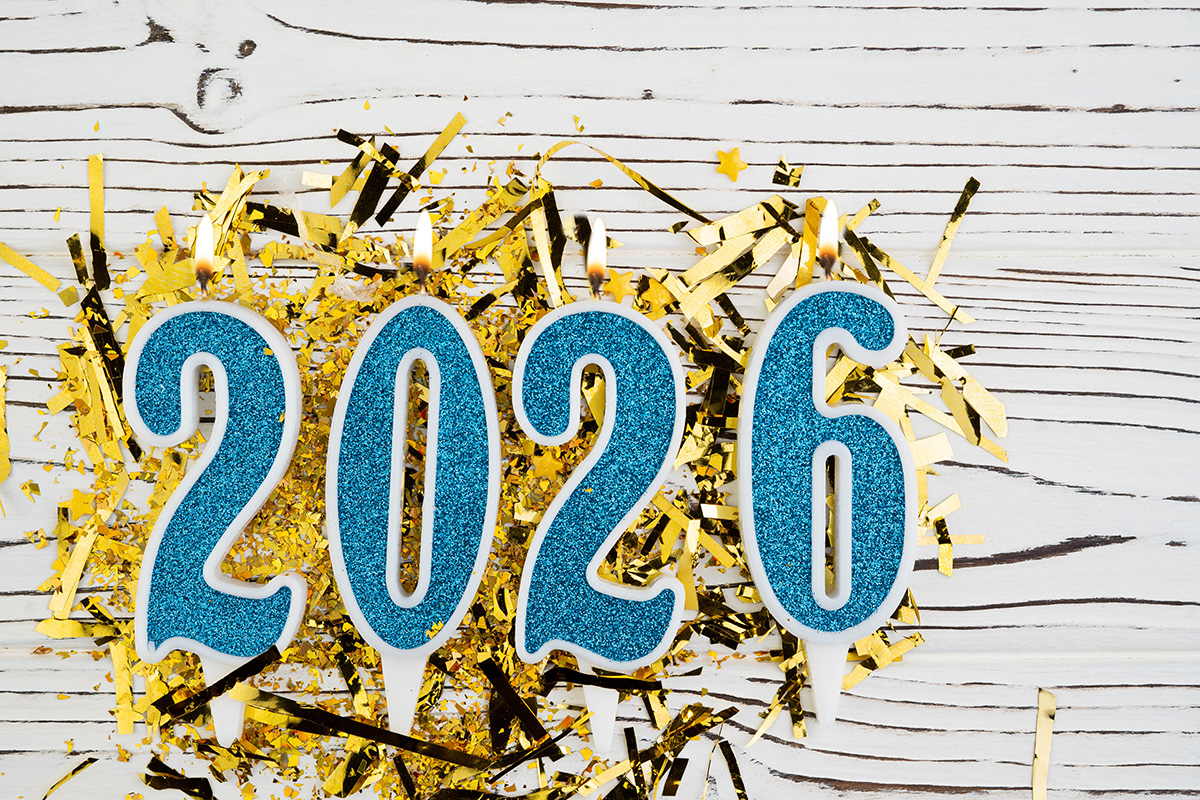
One year gone, another just beginning. The best of all worlds would be no regrets about how you lived your life in 2025, and a positive outlook for 2026. I wish that for all of you, along with good health and happiness.
For me, 2025 was a good year. No new health issues as long as I don’t consider my recent root canal. Friends kidded if that was my worst, life is OK. But then they didn’t sit in the dentist chair for three hours. As you are aware, if reading this in the Blade, I write about politics. The felon in the White House ensures there is always something to write about. Unfortunately, it’s 99% bad. He recently said he will interfere in Europe, and support far-right parties. Not surprising for him, and his fascist leaning administration. Again, as you know, I usually refer to him as ‘The felon,’ my most polite name for him. He has a slew of scary incompetents around him, but truly frightening are the fascists like Russell Vought at OMB who wrote Project 2025, and his personal Goebbels, Stephen Miller. They are proposing policies that are destroying lives. While many don’t impact me, they create a certain amount of guilt in how I live my life. I am a white, privileged, cisgender, older, male and can escape the immediate repercussions of some of the worst things happening in the world today. Nearly all perpetrated, or supported, by the evil SOB in the White House. There, another name for him.
As long as my Social Security keeps coming, and Medicare still pays 80% of my doctor bills, I should be OK. In 2025, I continued to join friends every morning for coffee. In D.C. at Java House; in Rehoboth Beach, it’s The Coffee Mill, owned by my good friends Mel Damascena and Bob Cartwright.
My regular column allows me to vent and comment on the world. My second column is the Blade’s Comings & Goings column. It lets me share the successes of so many in the LGBTQ community. We have a truly amazing community, of which I am so proud to be a part. In 2025, I also began my second book, this one on politics, but don’t hold your breath for a publication date. I am also a theater reviewer for the Georgetown Dish. I get to see as many plays as I like, and share thoughts about them. Mind you, I call myself a reviewer, not a critic. I always try to find something nice to say about every production, even if I don’t recommend others see it. Maybe a good actor, great scenic designer, always something good even in a bad production.
I am fortunate to continue to travel. Now it’s on cruise ships. Great to unpack once, and know where the bathroom is. This past year I went on two cruises, and the Blade was kind enough to publish my blogs. One, a bucket list cruise, something I wanted to do for over 40 years, to the Norwegian Fjords, and the Arctic. Twelve days on Celebrity APEX out of Southampton. It was amazing, and met all my expectations. The second was my recent transatlantic cruise, something I do annually, with a large group of friends from around the country, and world. It was 13 nights from Rome to Ft. Lauderdale. I’ve already booked next October; 16 nights on Celebrity XCEL, Barcelona to Miami. I even have two cruises booked in 2027, one a transatlantic, the other a river cruise on the Douro, in Portugal. Feel free to join me if you like cruising, at least the kind done on the water.
All-in-all, 2025 was a good year. I look forward to the same in 2026. More travel, including a barge trip in June from Lyon to Paris, through the canals of Burgundy. I hope for good health, time with good friends, and more writing. In addition, I promise my friends, and community, I will continue to fight with, and for you, trying to make our lives better. I will demonstrate against the felon and his policies, work hard to elect Democrats, especially my friend Zach Wahls, running for United States Senate in Iowa. I will stand up, and speak out, for my trans friends, and friends who are immigrants, all threatened by the felon.
I ask you to join me and do everything we can to take back our country and look forward to maybe seeing many of you on a cruise, but definitely on the battle lines, here at home. Together, we can work in 2026 and beyond, to ensure everyone can live the life they want, and deserve; in what again must be the land of the free and home of the brave.
Peter Rosenstein is a longtime LGBTQ rights and Democratic Party activist.
Opinions
Trump’s ‘American people derangement syndrome’
Voters must stop him before he destroys democracy

Trump, in a deranged, evil, post on X, accused Rob Reiner of suffering from “Trump derangement syndrome.” I guess that would apply to everyone who thinks Trump is an evil, dangerous, asshole who is trying to destroy our society as we know it. With that definition, I would surmise the felon himself suffers from “American people derangement syndrome,” because clearly, he thinks we are all evil, dumb, assholes, and a danger to him, and the fascists surrounding him.
His speech to the nation was called bellicose, by the New York Times. I would call it unhinged and vile. It was a plea to the populace, containing a pack of lies, to continue to believe his lies, and distortions. We all know the felon is full of shit when telling us prices have come down. We go shopping every week to feed ourselves and our families, even if he doesn’t. We have to pay heating and rent bills each month. We know since he became president nearly a year ago, all those costs have gone up. Talk to any honest person at a chamber of commerce in your area, and they will tell you small businesses are suffering. They will tell you the felon’s tariffs are hurting everyone. We know he is screwing the poor and middle class; trying to end SNAP benefits, and refusing to help with healthcare costs. All the while giving tax breaks to corporations, and the rich. People are not dumb Mr. Felon, and your lies are no longer resonating.
The evil, deranged, felon in the White House lives in a world where he can do favors for his friends in return for getting them to donate hundreds of millions for his follies. He is a grifter who hosts dinners for rich people to make money for his crypto business. He is said to have made more than $3 billon since his election. This while farmers are going broke, and losing their farms, because his tariffs screwed them. He is undermining vaccines and caused a measles epidemic in the United States. This a disease eradicated before he came into office. He ended grants to research cures for HIV/AIDS, Parkinson’s, Alzheimer’s, cancer, and an assortment of childhood diseases. He stopped research grants for mRNA vaccines. When we have the next pandemic, and it will come, that will result in millions of deaths, all on his head.
He is embarrassing the United States around the world. They watch him give unhinged speeches, raise and lower tariffs irrationally, screw our allies, and now trying to interfere in their elections. He is bombing fishing boats, claiming they are carrying drugs, with no proof at all. Then he releases from prison the man who brought more cocaine into the country than anyone else ever did. All this is what the lying, cheating, grifting, evil, heartless, felon in the White House, is doing to you, the good people of the United States, and the world. He sounds more unhinged every day while trying to blame everything on former President Biden and Democrats, who haven’t controlled the levers of government in nearly a year.
I know the results of the 2025 elections must scare him. They show him the majority no longer accept his BS. We will go into 2026, and the midterm elections, with our eyes wide open. He wants to be King and we don’t want kings in our country. He has what his chief of staff calls, “an alcoholic’s personality” “because he believes there’s nothing he can’t do.” She is right about that, but we will call him on it in the next election. We will say clearly, with our voices, and our votes, “no more, enough is enough.” We are taking back the country and will throw out anyone in office who still supports him.
We try and forgive those who voted for him, as long as they now recognize he lied to them, and is screwing them. Young people must understand they will suffer their whole lives because he is a climate denier. Latino and Hispanic voters, who believed he was going to support them, now see he wants to deport them. Farmers who once thought he supported them, until he screwed them. We must now all join together, and show the evil SOB in the White House, who is building his grand ballroom, taking planes, and other gifts, and pardoning the guilty; his time is coming to an end. Again, we will go into the voting booth, eyes wide open, and vote to stop him before he completely destroys our lives, our families, our democracy, and brings fascism to our country.
Peter Rosenstein is a longtime LGBTQ rights and Democratic Party activist.
Opinions
Using movement to boost your mental health during holidays
Sometimes the goal is simply steadiness

We’re told this is the season of Ho Ho Ho. Joy. Family. Home.
But let’s be honest. The holidays are stressful for almost everyone. Even in the best situations, this time of year comes with pressure. Expectations. Family dynamics. Financial stress. Comparison. The emotional labor of trying to make everything feel warm and magical while quietly holding a lot inside.
For some people, home is comfort. For others, it’s complicated. A place where old roles come back fast. Where you’re expected to be a version of yourself that no longer fits. Where love exists, but understanding feels incomplete.
And for many of us in the LGBTQ community, that stress can carry extra weight. Sitting at tables where parts of who you are feel debated instead of celebrated. Navigating politics and beliefs that don’t feel abstract, but personal. Deciding when to speak up, when to stay quiet, and when to just go refill your drink. Grief changes how the holidays land.
For me, the holidays have often been quiet. I’m deeply grateful for the family I still have and the support they’ve given me, and I also need to be real. I’ve been jealous. Jealous AF. Jealous that I can’t go home and hug my mother. Jealous that my dad isn’t there. Jealous when I see the cozy movie version of the holidays play out in other people’s lives. Not because they don’t deserve it, but because I wish I had it too.
Long before fitness became my career, the gym was my sanctuary. Without movement, these seasons would have been much harder. My body changed as a byproduct, sure, but what movement gave me first was something more important. Stability. A place to put grief. A way to move stress out of my body when words weren’t enough. Stress doesn’t just live in the mind.
We like to think stress is something we can talk through or think our way out of. But stress and anxiety live in the body. Chronic stress has been shown to disrupt sleep, weaken the immune system, and show up physically as tension, fatigue, and pain. When it’s left unaddressed, it doesn’t just affect how we feel emotionally. It affects how we function.
Most people don’t come into fitness because they’re thriving. After 20 years of coaching, almost everyone I’ve met started with physical goals. Lose weight. Build muscle. Look different. What they don’t always see is how stress, burnout, emotional eating, and putting everyone else first got them there. Most people aren’t failing. They’re exhausted.
When we talk about mental health, we think about therapy, medication, boundaries, vacations, or staying away from that one family member who always finds a way to press your buttons. All of those things matter. They save lives. But movement is rarely treated as part of the mental health plan, even though every single person who moves consistently feels better mentally. Not perfect. Just better. As my business partner Chase likes to say, sexy is the side effect. This isn’t just empathy. It’s a strategy.
The holidays don’t sneak up on us. We know which dinners will be hard. We know which brunches will test our patience. We know which days we’ll feel alone. So instead of raw-dogging our way through it, we can prep for it.
First, plan your movement the same way you plan the hard stuff. If you know a dinner is going to be stressful, don’t show up already hot. Schedule your workout that day, the day before, or in the days leading up so your nervous system is already in a better place. You’re not trying to win the day. You’re trying to lower the starting line.
Second, give yourself time limits. You don’t have to do the full four hours. There’s a lot of space between not showing up at all and staying until you’re emotionally fried. Do an hour. Schedule a fake work meeting if you have to. Show up in a way that lets you stay in character and protect your peace. That still counts.
Third, move how you can move. If you’re traveling, alone, out of routine, or your gym is closed, it doesn’t have to be perfect. Twenty minutes works. A walk works. A jog works. A short breathing or meditation session works. Even a quick bodyweight circuit in your childhood bedroom works. And if you need ideas, we share our monthly programming and workouts on the SWEAT DC Instagram so anyone can follow along and move, wherever they are.
Fitness doesn’t have to look good to be effective. It just has to be intentional. Especially this time of year.
As the year comes to a close, my hope isn’t that this season suddenly feels easy. It’s that you feel supported. That you remember movement isn’t about punishment or perfection. It’s about care.
Sometimes the goal isn’t happiness. Sometimes the goal is steadiness. And honestly, some years, that’s a win. We can do that. And we don’t have to do it alone.
Gerard Burley, also known as Coach G, is founder and CEO of Sweat DC.

